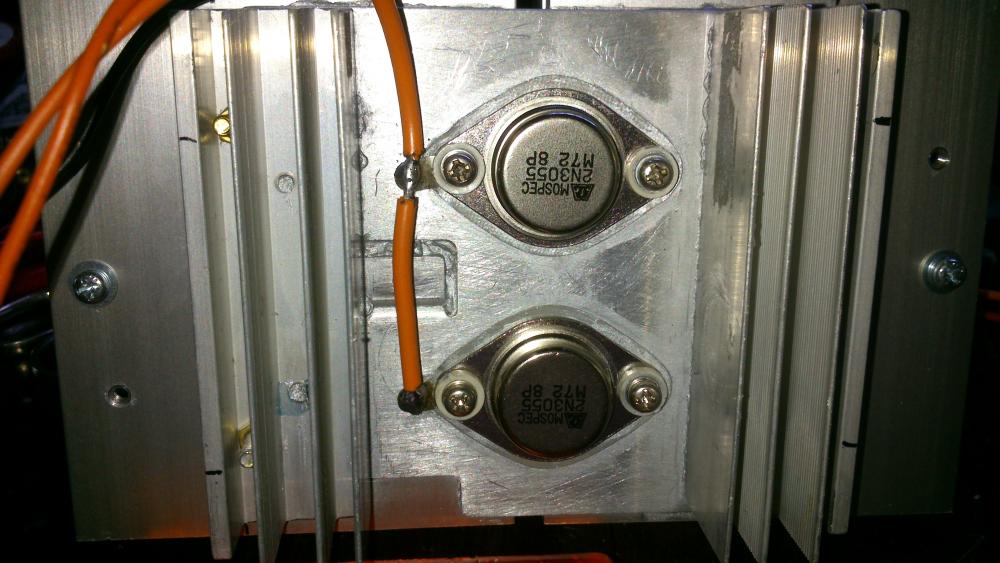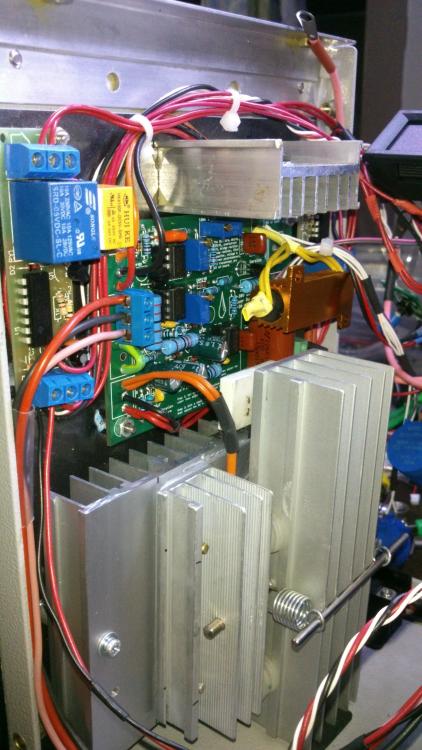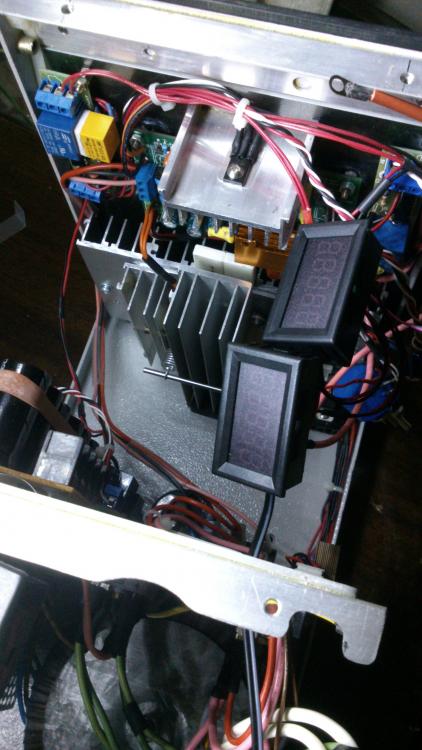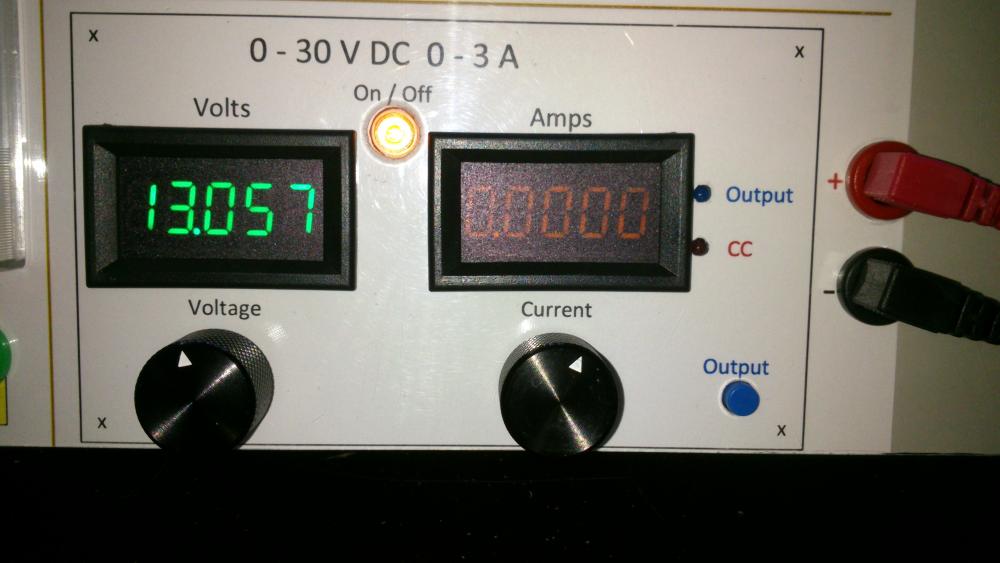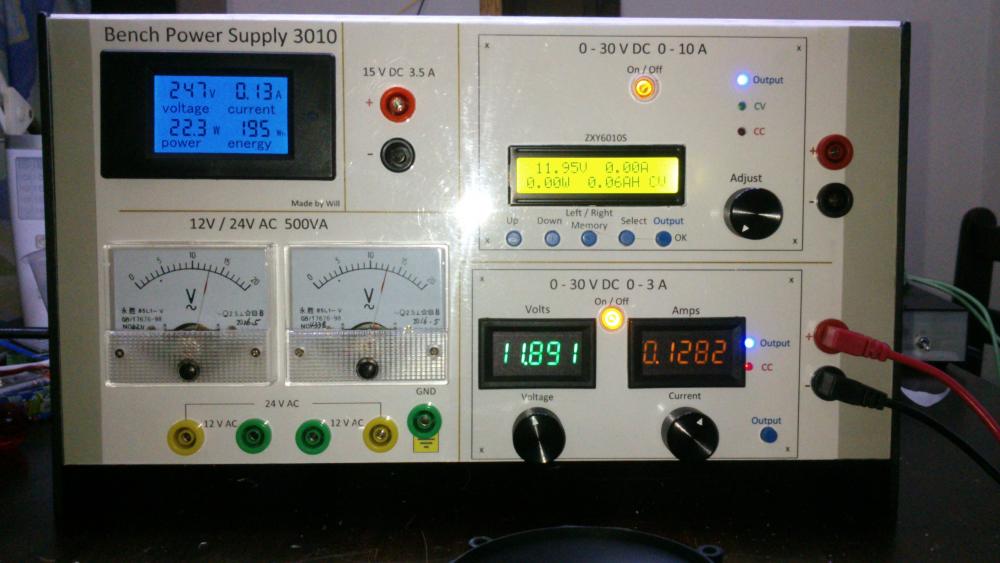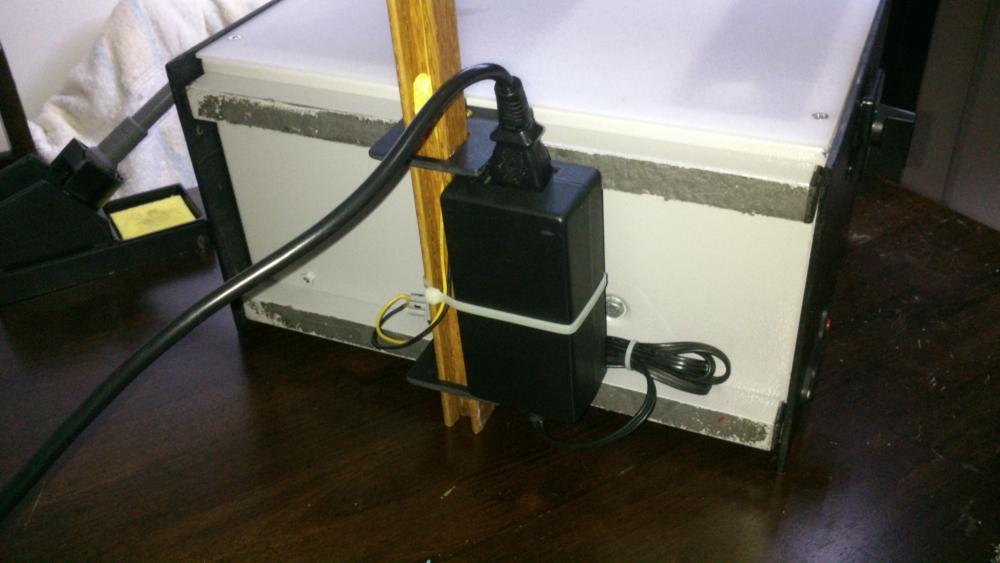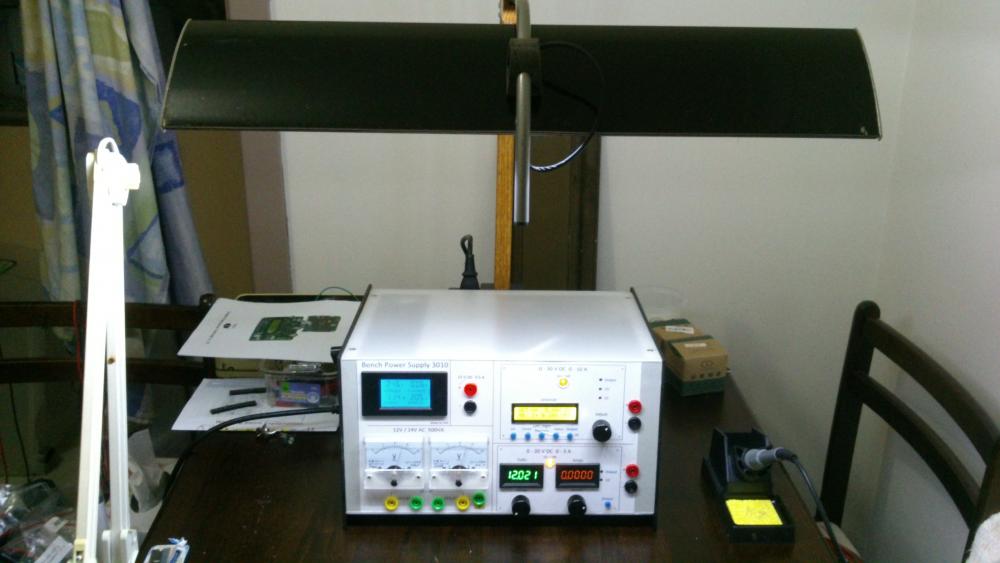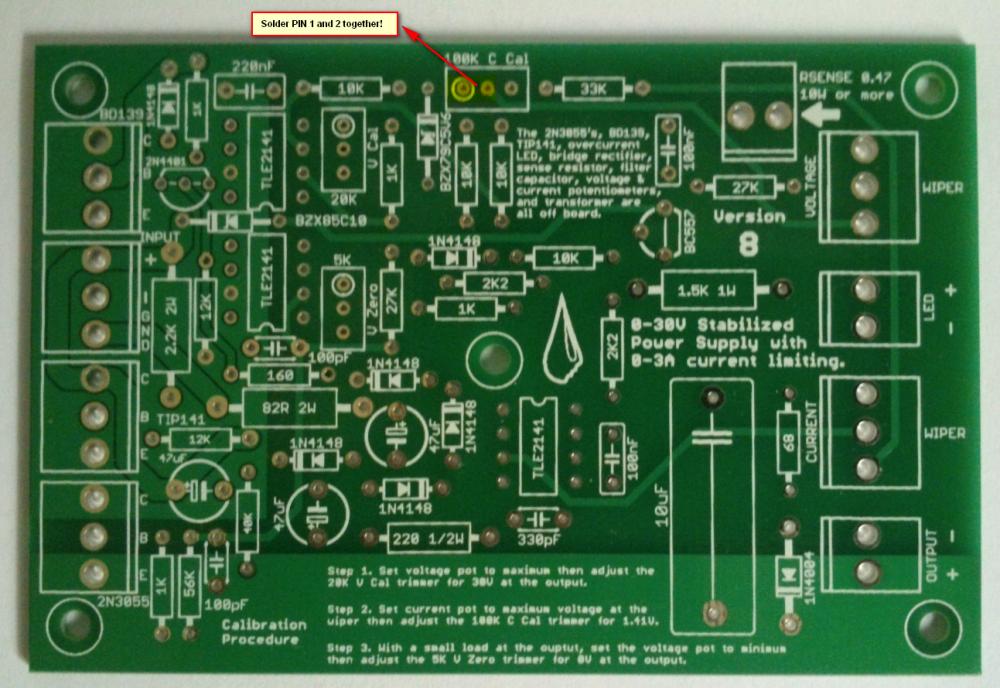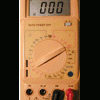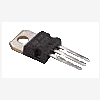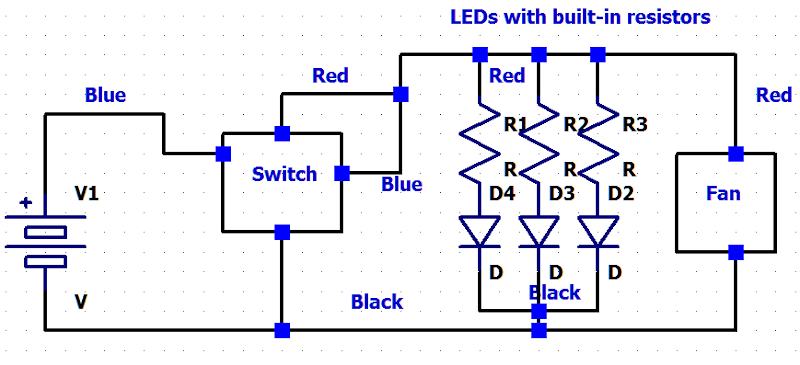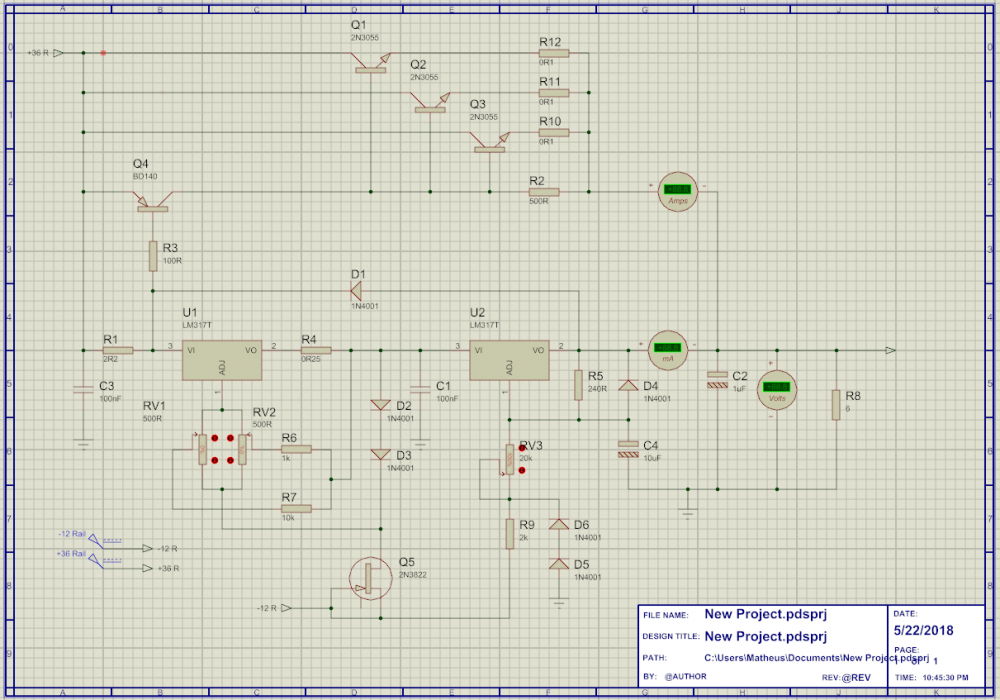Leaderboard
Popular Content
Showing content with the highest reputation since 07/27/2015 in all areas
-
0-30V 0-3A Latest Data
AsSa and 3 others reacted to repairman2be for a topic
Hi all, Finally after some months have gone by, my build of the Power Supply is done. I have used liquibyte schematic Rev. 8 and had made the cirquit board according to the Gerber.zip file he posted here: 0-30V Stabilized Power Supply Page 88 posted October 6, 2014 "http://electronics-lab.com/community/index.php?/topic/29563-0-30v-stabilized-power-supply/&page=88" I left out D10 and R15 as per his description. I have plenty of boards leftover if someone has a need for it. There was only one mistake liquibyte made which have outlined in one of the pictures uploaded here. I was fortunate enough to get a big case with a Toroidal transformer from the scrapyard. Also many parts are recycled from various sources. Regards, William4 points -
Finally, my post with the Eagle .sch and .brd, full gerbers, and parts list for Digikey in a zip file. I'm also including many of the pics I took as I was building that were posted both before and after this post. I'm still not completely done and may add more pics later. One thing I have changed is the third transformer for the auxiliary circuitry for the temperature sensor and fans and the displays (I wanted a better transformer than the Radio Shack special I had on hand). Archive attached. 30V.zip3 points
-
Solar-powered Bee Hotel w/ Particle Argon (ongoing project)
Jolin He and one other reacted to JamesMVictoria for a topic
Nice one, I like it.2 points -

How to easily turn on/off all debug message on Arduino IDE
SharonWatkins and one other reacted to MrNams for a topic
But even if we disable debug, it will call print method and do not print anything. I mean we should make it something like #ifdef DEBUG Serial.print("\n debug controlled print"); #endif Here when we disable macro, its like code is not written for compiler, code will be removed in macro processing itself.2 points -

H Bridge PWM DC Motor Driver + PCB
senaka ranathunga and one other reacted to sam.moshiri for a topic
An H-Bridge (Full-Bridge) driver is quite popular in driving loads such as brushed DC motors and it is widely used in robotics and industry. The main advantages of using an H-Bridge driver are: high efficiency, rotation direction change, and braking the motor. In this article/video, I have introduced a complete H-Bridge DC motor driver using four IR3205 power MOSFETs and two IR2104 MOSFET drivers. Theoretically, the above-mentioned MOSFET can handle currents up to 80A, however, in practice we can expect to get currents up to 40A if the MOSFET temperature is kept as low as possible, using a big heatsink or even a fan. References Article: https://www.pcbway.com/blog/technology/Powerful_H_Bridge_DC_Motor_Driver.html [1]: IRF3205 Datasheet: http://www.irf.com/product-info/datasheets/data/irf3205.pdf [2]: IR2104 Datasheet: https://www.infineon.com/dgdl/Infineon-IR2104-DS-v01_00-EN.pdf?fileId=5546d462533600a4015355c7c1c31671 [3]: 1N5819 Datasheet: https://www.diodes.com/assets/Datasheets/ds23001.pdf [4]: IR2104 Schematic Symbol, PCB Footprint, 3D Model: https://componentsearchengine.com/part-view/IR2104PBF/Infineon [5]: IRF3205 Schematic Symbol, PCB Footprint, 3D Model: https://componentsearchengine.com/part-view/IRF3205ZPBF/Infineon [6]: CAD Plugins: https://www.samacsys.com/library-loader-help2 points -

Non Contact Hand Sanitizer Dispenser, Easy, Cheap, No Arduino!
sam.moshiri and one other reacted to admin for a topic
Thanks for sharing your project with us. Could you give more details on the control board?2 points -
The original circuit should work fine up to 15V at 1A if you replace the old opamps with the newer higher voltage ones. You probably should recalculate the resistors that set the maximum voltage and current outputs. If the Chinese kit uses the transistor that shorts the opamp output when the power is turned off then the resistors that feed the transistor need to be recalculated for the reduced voltage. I have used perforated stripboard for many projects including very complicated ones. The copper strips are cut to length with a drill-bit and become almost half the wiring of a pcb. The parts and a few short jumper wires become the remainder of the wiring. Only one wire is in each hole so changing a part is easy like on a pcb.2 points
-
Hi, as promised I made an English translation of my working. Maybe there is few mistakes and I am sorry for that ! Good reading. ExplicationEN.pdf2 points
-
I use copper wire, not rice wire. They put rice in everything they make, especially batteries.2 points
-
0-30 Vdc Stabilized Power Supply
electron234 and one other reacted to elctro123 for a topic
So Finally which version of schematic is correct / flawless to build the PSU ?2 points -
February 23 above on this page has the latest schematic of the revised 3A lab power supply.2 points
-
Does anyone has LM3914 pspice library? i desperately need it..pleeeeease!2 points
-

Low power solenoid?
AmelieScott and one other gave a reaction for a topic
I want to apply force for an extended amount of time (10 secs to a couple minutes) using a solenoid actuator. Unfortunately, it seems that solenoids use a lot of power when they are active. Is there a solenoid type that will only use power when switching between active and not active? There's probably a way I can do this with an external mechanism, but I was wondering if there may be commercial solenoids that have this built-in. Thanks, Jessica2 points -
Illegal content (ebook/magazines/software) will be deleted without any notice. Thanks2 points
-
Overload Protector A16 ???
joeydennis11 and one other reacted to tjolle62 for a topic
In a few circuit diagrams i have they refer to a what seems to me is a transistor with B C E as a overload protector and with number A16 and i have looked for a few hours on the net and i can't find anything on this little fellow, Anyone knows what I'm looking for and wanna share that info Please .... Come on !! 48 visits !! some one must know what it is !!! PNP is it also...........2 points -
Overload Protector A16 ???
joeydennis11 and one other reacted to tjolle62 for a topic
At last i got a theori from a totally different place and he wasn't shure either but he had a weak memory that it could be 1A16 and a PNP transistor but after several deep searches on the I-net it didn't make any kind of senses whatsoever ???2 points -

Car battery to parallel port
tracythomas50 and one other reacted to MP for a topic
When you use your resistive divider to drop the voltage down to 5 volts, you just need to select values of resistors to limit the current. This is basic ohm's law. V/R. Was this your question or did I misunderstand? I am not sure how you intend to monitor status by using one 5 volt pin. As an interface to the parallel port, you could use an LM3914. This would give you the resolution you need. There are also many other ways to proceed. You need to convert from analog to digital to read anything useful from the parallel port. MP2 points -

Car battery to parallel port
tracythomas50 and one other reacted to Omni for a topic
Hi TJBraza, http://www.analog.com/UploadedFiles/Data_Sheets/ADT7485A.pdf Although, it will probably require a small program written in C or Visual basic to convert the string MSB & LSB into a more easier read etc... Take a moment and review the data sheet, the IC has a lot of potential.2 points -
SL100 & SK100 transistor
AmelieScott and one other reacted to alanng96 for a topic
I can't find SL100 & SK100 transistor :'( Which transistors can replace these? Thank you for your help~ ;)2 points -
Calm down people. It is not Mixos's fault, if it is against the law he has to remove the content. This site is very good for asking electronic related questions, I have yet to find a better one.2 points
-
Integrating DHT11 with Beetle ESP32 C3 and Home Assistant
JamesMVictoria reacted to CETECH for a topic
This project will allow you to monitor environmental conditions in your home automation setup. Here are the steps to achieve this: Integrating DHT11 with Beetle ESP32 C3 and Home Assistant 1. Components Required Before we begin, gather the necessary components: BeetleESP32C3 development board DHT11 temperature and humidity sensor Jumper wires USB cable for programming A computer with the Arduino IDE or ESPHome installed Get PCBs for Your Projects Manufactured You must check out PCBWAY for ordering PCBs online for cheap! You get 10 good-quality PCBs manufactured and shipped to your doorstep for cheap. You will also get a discount on shipping on your first order. Upload your Gerber files onto PCBWAY to get them manufactured with good quality and quick turnaround time. PCBWay now could provide a complete product solution, from design to enclosure production. Check out their online Gerber viewer function. With reward points, you can get free stuff from their gift shop. Also, check out this useful blog on PCBWay Plugin for KiCad from here. Using this plugin, you can directly order PCBs in just one click after completing your design in KiCad. 2. Flashing ESPHome to Beetle ESP32 C3 Install ESPHome on your computer. You can follow the instructions in my previous blog. Create an ESPHome configuration file (e.g., dht11.yaml) with the following content: sensor: - platform: dht pin: 0 model: dht11 temperature: name: "Living Room Temperature" humidity: name: "Living Room Humidity" update_interval: 5 s Replace placeholders (YourWiFiSSID, YourWiFiPassword, etc.) with your actual values. Compile and upload the configuration to your Beetle ESP32 C3 using the ESPHome CLI. 3. Integrating with Home Assistant Open Home Assistant. Click on Configuration (bottom left) and go to Integrations. Click the + button and select ESPHome. Enter the IP address of your ESP32 (leave the port as 6053) and click Finish. 4. Viewing Temperature and Humidity Once integrated, Home Assistant will discover the Beetle ESP32 C3 module and create entities for temperature and humidity. You can access these entities in Home Assistant’s dashboard and display them as cards or graphs. And that’s it! You’ve successfully integrated the DHT11 sensor with your Beetle ESP32 C3 and Home Assistant. Feel free to customize and expand this project based on your needs. Happy monitoring! 🌡️💧🏠1 point -
1 point
-
the USB tester
NieveHopkins reacted to bidrohini for a topic
You can take a look at the Klein Tools VDV512-101 Cable Tester.1 point -

DIY - ARDUINO BASED CAR PARKING ASSISTANT
davidjackson reacted to Ashish Adhikari for a topic
Introduction ---------------- Hi Friends, I am back again with another Arduino based home automation project. This time I am trying to make my partner's life easy by installing a collision avoidance system in the garage to help her park the car safely without hitting the garage wall. So, in this video, I am going to use an ultrasonic sensor to calculate the car's distance from the garage wall and display it using green, yellow and red LEDs. The color of LEDs indicates whether to keep moving, slow down, stop or go back. The total cost of the project is around $20 - $25. Step 1: Logic The project has 3 phases Phase 1: Waiting for the car In this phase the device keeps looking for a moving object within the sensors proximity. If an object enters the proximity then one of the three LEDs turns on based on how far the moving object is. If the object is way too close, then a noise is made to make the moving object aware of the distance. Phase 2: No car in the garage If there is no object in the proximity then turn off all the LEDs. Phase 3: The car has stopped moving (Parked in the right spot) If the object has stopped moving and is still in the proximity wait for 20 CPU cycles and then turn off the LEDs. Step 2: Hardware Requirement For this very simple project we need: - A Perfboard - An Arduino nano/uno (whatever is handy) - A Red, Green and a Yellow LED (Light Emitting Diode) - 3 x 220ohm resistor for the LEDs - One HC-SRO4 Ultrasonic Sensor - A Buzzer shield or A buzzer and a 100 ohm resistor - A 220v AC to 5v DC Buck step-down module - One Female Pin Header Strip - An Ethernet cable - Some connecting cables - A USB cable to upload the code to the Arduino - and general soldering equipments Step 3: Assembly Let start by connecting the LEDs to the board. Connect the Red LED to pin D2, Yellow LED to D3 and the Green LED to D4 of the Arduino by putting in a 220ohm resistor between the Arduino board and the LEDs. Now lets connect the Buzzer to analogue pin A0. Next, connect the Trig pin of the Ultrasonic Sensor to D5 and the Echo pin to D6 of the Arduino. Once all the modules are connected to the Arduino board, its time for us to connect all the positive and negative pins together. Connect all the positive pins of the modules to the +5v supplied by the Buck Step-Down Module and the negative pins to the -ve terminal of the Module. That's it, we can now upload our sketch to the board. In this assembly I am using 3 LEDs to display the distance, however you can replace the 3 LEDs with a RGB LED, or you can also use an array of LEDs like an audio level indicator to display the movement of the car. Step 4: My Setup OK now lets see what I have made. I have installed the Arduino, buzzer, the ultrasonic sensor and the three 220 ohms resistors on one Perfboard. The 3 LEDs and the power module is installed on a second Perfboard. I will be covering the LEDs with a translucent cover to give it a nice look. The 220v power supply will be connected to the screw terminal block. The base unit will then be connected to the LEDs and the power supply with an Ethernet cable. Step 5: The Code int trigPin = PD5; // Sensor Trip pin connected to Arduino pin D5 int echoPin = PD6; // Sensor Echo pin connected to Arduino pin D6 int redLED = PD2; // Red LED connected to pin D2 int yellowLED = PD3; // Yellow LED connected to pin D3 int greenLED = PD4; // Green LED connected to pin D4 int buzzer = A0; // Buzzer connected to Analogue pin A0 long TempDistance = 0; // A variable to store the temporary distance int counter = 0; // Counter value to check if the object has stopped moving void setup() { Serial.begin(9600); pinMode(trigPin, OUTPUT); pinMode(echoPin, INPUT); pinMode(redLED, OUTPUT); pinMode(greenLED, OUTPUT); pinMode(yellowLED, OUTPUT); pinMode(buzzer, OUTPUT); } void loop() { long duration, Distance; digitalWrite(trigPin, LOW); delayMicroseconds(2); digitalWrite(trigPin, HIGH); delayMicroseconds(10); digitalWrite(trigPin, LOW); duration = pulseIn(echoPin, HIGH); Distance = (duration/2) / 74; // Distance in Inches if(counter < 20){ // Do the rest if the car is still moving if (Distance > 200) { // Nothing in the garrage turnThemAllOff(); } if ((Distance > 55) && (Distance <= 200)) { // Turn on Green LED digitalWrite(greenLED, HIGH); digitalWrite(yellowLED, LOW); digitalWrite(redLED, LOW); noTone(buzzer); } if ((Distance > 15) && (Distance <= 55)) { // Turn on Yellow LED digitalWrite(yellowLED, HIGH); digitalWrite(redLED, LOW); digitalWrite(greenLED,LOW); noTone(buzzer); } if (Distance <= 15) { // Turn on Red LED digitalWrite(redLED, HIGH); digitalWrite(greenLED,LOW); digitalWrite(yellowLED, LOW); noTone(buzzer); } if (Distance < 8) { // Item is way to close - start the buzzer tone(buzzer, 500); } } if ((Distance == TempDistance) || ((Distance+1) == TempDistance) || ((Distance-1) == TempDistance)){ if(counter >= 20){ // Turn off the lights if the object hasn't moved for 20 cycles (no change in distance) Serial.println("No movement detected, turning off the lights"); turnThemAllOff(); } else { counter++; } } else { counter = 0; // Reset counter if there is a movement } TempDistance = Distance; Serial.print(Distance); Serial.println(" inches"); Serial.print("Counter : "); Serial.println(counter); delay(500); } // Function to turn the LEDs off void turnThemAllOff(){ digitalWrite(redLED, LOW); digitalWrite(greenLED,LOW); digitalWrite(yellowLED, LOW); noTone(buzzer); } Start the code by defining the constants and the global variables that will be used throughout the code. Then define the pin modes in the setup section of the code. Then create a function to turn off all the LEDs and the buzzer. Now, calculate the "Distance" in inches by reading the values received from the Ultrasonic Sensor. Then by checking the value of the "Distance" we will turn on and off the LEDs based on how far the object is. If the distance is greater than 200 then turn off all the LEDs and the buzzer as the object is out of range. Else if it is between 55 and 200 then turn on the green LED. If the object is between 15 and 55 then turn on the yellow LED, and if the object goes closer than 15 inches then turn on the red LED until it reaches 8 inches. When the distance becomes less than 8 start the buzzer along with the red LED. Next bit of the code is to set the value of the counter based on the cars movement which then decides when to turn off the LEDs. It compares the value of "Distance" with the "TempDistance" and if the values are same (object hasn't moved) then increments the counter. If the object moves any-time during this process the counter is reset to 0. Finally the "TempDistance" is set to the value of "Distance". Just before comparing the Distances we also need to check if the counter value has exceed 20. I am doing this to stop the below code from executing if the car is in a steady position. Lastly we just need to add a small delay to our sketch to pause the code for a while. Step 6: Quick Demo So this is how I have installed the unit in my garage. As I walk close to the sensor the light changes from green to yellow to red and ultimately the buzzer goes on when I am too close to the sensor. In my case I have installed the buzzer next to the Arduino however I will recommend you to install the buzzer along with the LEDs. If you want you can also flash the red LED when the buzzer goes on. So now, my partner can park the car easily without making any assumptions. Doesn't matter how many times she fail her driving test she is not going to break my wall (even when she is drunk). Not that I am asking her to drive when she is drunk (just kidding). Thanks again for watching this video! I hope it helps you. If you want to support me, you can subscribe to my channel and watch my other videos. Thanks, ca again in my next video.1 point -

Touchless Covid Free Electronic Dice Using Arduino
Ashish Adhikari reacted to charlesmox1 for a topic
I'm looking forward to the next post)Keep it up!1 point -
1 point
-
Rechargeable D Cell Batteries And Silver Wire Making Ring
Satyadeo Vyas reacted to chanbuz for a topic
In this article, we survey d cell battery all Rechargeable D Cell Batteries is ideal and dependable. All battery execution is so acceptable on the grounds that we research all battery then we check all subtleties. At that point we recorded all data. We as of now compose the Longest Lasting D Batteries Reviews article you would first be able to check it. I trust this Rechargeable D Cell Batteries survey article is extremely useful for you. On the off chance that you need to know more updates you can follow our site since we audit the very best items and all innovation refreshes. For more info visit Chan Buz Silver wire for article making sterling Rings is helpful for you Sterling Silver Wire for Ring Making I hope you can find all the information about this. Some people like to make a ring using silver wire. In this article, we give you all information on the price of silver wire making rings and the best products. So first you can read our silver wire review article. Sterling silver wire 20 gauge is the best product of our listed items. First, we go to Amazon then we get all the information on this product then we list our notes Sterling Silver Wire for Ring Making. Then we begin reviewing our website. All our visitors already know that we review all the best and popular long lasting products.1 point -
Question electrolytic capacitor
17669 reacted to nogueiraat for a topic
my room the temperature varies 31-33º the humidity varies 55-70% this epcos information valid for other electrolytic capacitor manufacturers? in the 1990s were electrolytic capacitors or another type of capacitor used?1 point -

Non Contact Hand Sanitizer Dispenser, Easy, Cheap, No Arduino!
Sugandhan Vazhumuni reacted to sam.moshiri for a topic
You're welcome. it doesn't have a controller. the intention was to find the easiest and cheapest solution. Please follow the video and provided resources.1 point -
PCBGOGO after-sale service review
dorrismillerrr123 reacted to KrisDong for a topic
The board is made very precisely, it's clean and very pleasant to touch. Markings on the silkscreen layer are very good readable. Soldering does not cause trouble, tin adheres very well to soldering points with a small amount of flux. It is also worth mentioning that the PCB is very robust to desoldering. The company is very solid, although you order 10 pieces, you get at least 1 PCB more for test, prototype, present, etc. When I signed up for an account, I also got a $20 coupon for free. Excellent construction and assembly work done by PCBgogo.No problems encountered, highly recommended.1 point -
I cannot see which connects to what. Can you provide a schematic?1 point
-
The original defective circuit had many overloaded parts that will blow up. The improved version fixes it. Opamp U3 senses the output current in R7 and reduces the output voltage and output current to match the current set with P2. The maximum output current is 3.0A in the improved circuit and the two output transistors have a total maximum current rating of 30A so they will not blow up with only 3.0A.1 point
-
Why do you show an LT1038? it is obsolete and is not made anymore. It is impossible for it to dissipate 32V x 10A= 320W. Its datasheet shows that with a huge heatsink with fan or with liquid nitrogen for cooling it can dissipate only 120W. Its control circuit gives 10A only when its input to output is a few volts and cuts the max current to 2.5A when the input to output is 30V.1 point
-
BGA rework Process?
hunghoang reacted to soldertools1 for a topic
Hey, I also found a training institute and an article about BGA Rework Process. Follow the given link below to get a clear understanding of reworking BGA process: http://www.solder.net/services/bga-rework-services/1 point -
In need of a great bench power supply
davidjackson reacted to Bortmoun for a topic
Hi there. I need a good bench power supply, which i want to build myself, for my hobby lab. The thing is, i have been thinking about LM-317 as my linear voltage regulator (and because here where i live i don't have no access to better ones). The design must have these features: a)Current control from few mA to 5A b)Voltage control from 0V to 30V. For this purpose I've built this schematic, which i attached here. Please, tell me what you think about this project or if does work or does not, for i am a beginner in these things. R8 is just a dummy load. The things i need help: 1) How can i add a minimum load (10 mA as by LM-317 datasheet) to keep the power supply operating in different potentials? 2) I need a replacement for 2n3822, i can't find it in my country too. 3) Can I run it from a fixed switched power supply (way more cheaper than buying a transformer here)? 4) In the future, I'm thinking about adding digital control with PWM to this circuit with Arduino or something like that. Do you think this is feasible? Thanks in advance and sorry for my English. PS: i have already looked here in this forum about the 0-30v power supply with op amps, but i really like the LM-317 concept, although i will build this last one if my project fails.1 point -
750W DC Motor Speed Controler 0-100% with Schematic and PCB Layout
Youkito1991 reacted to davidjackson for a topic
Circuitmaker included one of the most friendly spice simulators, and I still find it more useful and easier to configure and use than the simulation packages in the high end "professional" packages. Good luck, there are lot of packages at various price points to choose from.1 point -

DIY - ARDUINO BASED CAR PARKING ASSISTANT
davidjackson reacted to admin for a topic
Thanks for sharing this project. I just edited it a bit, so code would look better.1 point -
Help Under standing Schematic PSU
Islam Amer reacted to Fliptron for a topic
Hi Islam, I'm a new user here (just signed up to answer your question), so I hope this helps. There seems to be several things that need to be understood about the overall topology of this PSU to get to answering your questions The power supply has two main parts: 1) The control section with the GHI outputs from the transformer, generates +12, -6, and -15. The ground of the control section (center point, more or less) is connected to the Positive side of the output. See ground below C4, and on the far right of the page (has the number 15 near by). (I think these numbers scattered through the schematic are test point numbers). So all of the control circuitry (anything using +12, -6 and -15) Is referenced to this ground. What is a little surprising, is that means that as the power supply output goes up/down, the control ground is doing the same. Also on this signal, is one end of the each of the six Load-Balance/Current-Sense resistors (6 x 0.36 Ohms). 2) The second part is the power section, which includes the lower half of the transformer (ABCDEF), the relays that select between the 4 voltages you listed (15-20-30-50), the bridge rectifier D7..10. The Negative side of the bridge is directly connected to the negative side of the output. (the line at the bottom of the page with label 14.) The Positive side of this bridge rectifier goes to the 6 collectors of the 2N3055s, then the 6 resistors mentioned above, then to the Positive side of the output, which as described above is also the ground of the control electronics. Since the maximum current is 3 Amps, and it will be shared evenly between the 6 resistors (with very minor differences depending on the exact characteristics of the six 2N3055s), the maximum current for each resistor is 0.5 Amp. So the max voltage across these resistors is 0.18 Volts , which gives about 90 mW , so these resistors are grossly over-sized at 5W, and will run cold (unless they are mounted on the heatsink). This also means the voltage on the 6 emitters is 0.00 to 0.18, which is averaged by the six 100 Ohm resistors and then sensed by U2 which implements the current limit circuit. U3 implements voltage control, follow pin 2 to the right which goes to the ground symbol, which we have established is power supply's positive output, and pin 3 which is connected to a voltage divider (including the front panel control) which connects to the negative side of the power supply, marked with the label 14. So now to get to your question. Regardless of what the output voltage is, the six emitters are no more than 0.18 volts above the ground of the control circuits, which tracks the positive output of the supply. The bases of these transistors will be 0.6 to maybe 0.75 volts above that. So the base voltage is always in range of the control circuit driving it. For the same reason, the 2.5V reference is an offset from the control section ground, and the power section's positive output. Yes, the six resistors also carry the base current, but this is minimal, compared to the collector current, due to the gain of the transistors. At DC, 25 deg C, and collector current of 0.5 Amps, the gain is over 100. I just did a Science (see picture below) to make sure I wasn't lying: With 15 volts on the collector, I got the following results: Vbe Ib Ic Volts mA mA 0.5 .05 3 0.56 .15 22 0.6 .36 82 0.61 .5 122 0.63 .7 190 0.65 1.0 280 0.67 1.26 370 0.7 2.2 600 (Note, Vbe is using the voltmeter in the PSU, which is not very accurate, and the transistor heated up on the last few measurements, and needed to be cooled) Anyway, the measurements I made show a gain on my test 2N3055 of about 300 when the collector current is around 0.5 amps which is the high end of what is expected in this power supply, and would contribute about 0.3% of the emitter current. Thinking a bit further, it doesn't really matter since it is sensed along with the collector current, and it all goes out through the positive output of the supply. Cheers1 point -
0-30 Vdc Stabilized Power Supply
HaddyS reacted to repairman2be for a topic
@Jeremy You may have 2 PCB's for AU$5 plus shipping in an envelope. Two boards weigh about 44grams. Email me if you would like some to: [email protected] Cheere, William PS. Seems your Kit has a problem to start with. Before I found this Forum I ordered two Banggood Kits. It is still not assembled and probably never will be. Anyway, over at this page there is a lengthy description on how to improve the Banggood kit. "www.paulvdiyblogs.net/2015/05/tuning-030v-dc-with-03a-psu-diy-kit.html"1 point -
Solar Powered Water Pump
Jordan&tiffany reacted to tripped for a topic
I have some questions I was hoping someone would help me work through. I am building an outdoor fountain that I want powered by a solar cell. Can I run the solar cell wires directly into the BLDC motor and have it operate only when sun is shining? The brighter the sun the faster the motor turns. Or do I need more circuitry to make it work? If I do hook up a small 3.7 v 2000 mAh Li Ion battery, I need a charge controller? And what? Pump Voltage VDC - 6.0 Nominal Current Draw: 0.27 Amps Power Usage: 7.0 Watts Solar cell Output Voltage: 0.5 volts (Vmax) Output Current: 3.5 Amps (Imax) Average Power: 1.75 Watts Is there any way to turn the motor on for 1 minute every hour on the hour? Miniature controller or driver of some sort? System as compact and concealable as possible. Any help out there For this one? Oh one more thing, is there a micro charge controller out there that would protect the battery when it was full by dumping the load into some LED’s or something of that nature?1 point -
Circuit Design Software On Linux:As Linux OS have become one of the most popular opensource OS for Servers and Desktop, many software will release a linux version . It also applies to the circuit design software .Since we are using the Linux as our Operationg System , and We would like to search some Circuit Design Software Based On Linux . So let me introduce some types of Circuit design software in order to make readers more esaily choose their favorite Linux-based software . 1.EasyEDA . As a cross-platform Circuit desgin software , which is used on the browser and stored on the clound server . EasyEDA provides shematic capture , pcb layout , spice simulation and online pcb order functions which will give you an easy EDA design journey and make your circuit design work more easily and more productively . You could run it on windows , mac , linux or android platform ,as long as there is one brwoser on the OS and connecting to network. Let me have a preview of what EasyEDA provides : I.Schematic capture This is a most important function of the circuit design software ,almost every circuit design software provides schematic capture function . Because it is the basic entrance of understanding the circuit you design . What is more ,it could be used to be converted into pcb design file . Here is a screenshot of one scheamtic : One Schematic—Arduino 2560 Schematic II.Spice simulaton . There are many spice simulation tools such as Multisim , Proteus, Ltspice , KtechLab . EasyEDA provides many simulation models and the quick way to building models for Integrated circuits . Also ,EasyEDA provides Waveform viewer to preview the simulation results . Spice Simulation Example . Spice Simulation Waveform Viewer III.PCB layout Almost all circuit design softwares provide PCB layout function . This is the way to produce the PCB board and the basic tool. EasyEDA provides laying out unlimited pads , size of the boards , and more than 6 layrers of PCB Boards. PCB Layout IV.Import from third-party EDA Tools EasyEDA can import files from Altium Designer , LTspice ,Eagle, Kicad . V.Export Files EasyEDA can export EasyEDA source ,SVG source ,SVG file ,Image(png),and Pdf files. VI.PCB Order . EasyEDA provides online ordering PCB. When completing your Circuit PCB Design , if you do not want to spend much time on making your own PCB , you could order online PCB . 2.DipTrace The second most popular software running on linux I would like to introduce is DipTrace . DipTrace is an EDA software for designing schematic and PCB boards . It is based on Windows ,Mac , Linux . The Developers provide mutil-lingual interface and tutorials . DipTrace has 4 modules: Schematic Capture Editor, PCB Layout Editor with built-in shape-based autorouter and 3D Preview & Export, Component Editor, and Pattern Editor. There are some basic Features about DipTrace : I.Simple UI II.Multi-sheet and hierarchical schematics III.High-speed shape-based autorouter IV.Smart manual routing tools V.Wide import / export capabilities VI.Advanced verifications with real-time DRC VII.Real-time 3D PCB preview & STEP export VIII.Manufacturing output There are five modules for DipTrace . Schematic Capture PCB Layout 3D Preview and Export Component Editor Pattern Editor 3.gEDA gEDA is so important for it is firstly started in an effort to remedy the lack of free software EDA for Linux/Unix . And one of the long standing goal for gEDA is to provide a suite od EDA application for Linux . All applications in the gEDA suite compile and run on Linux. So it is the software that I could not miss on introducing circuit design software on Linux. There are three main features gEDA provides: I.gEDA provides schematic capture : II.gEDA provides PCB Editor III.gerber file viewer Here I should have to mention the term “gEDA Suite”. The term“gEDA”refers to all free software projects and applications that have asscioated with the gEDA project . These include: · gEDA/gaf - gschem and friends (the original project) · PCB - PCB layout program · Gerbv - Gerber file viewer · ngspice - a port of Berkeley SPICE · GnuCap - A modern electronic circuit simulation program · gspiceui - A GUI front end for ngspice/GnuCap · gwave - An analog waveform viewer · gaw - An analog waveform viewer a rewrite of gwave. Works with gspiceui. · Icarus Verilog - A Verilog simulator · GTKWave - A digital waveform viewer · wcalc - Transmission line and electromagnetic structure analysis For the importance of Linux to electronic design ,the open-source developers recognize it many years ago , and the gEDA is the proof of their early insight . The gEDA Project remains a federation of software tools developed by different (but sometimes overlapping) programmers. The thread which holds the project together is the shared vision of creating a powerful, community-based, open-source EDA toolkit. 4.Qucs Quite Universal Circuit Simulator (Qucs) is an open-source electronic circuit simulator software release under the GPL . It give you the ability to setup a circuit with graphical user interface and simulate the large-signal, small-signal and noise behaviour of the circuit. Qucs supports a growing list of analog and digital components as well as SPICE sub-circuits. It is intended to be much simpler to use and handle than other circuit simulators like gEDA or PSPICE. 5.Magic Now let me introduce a very-large-integration layout tool originally written by John Ousterhout his graduate students at UC Berkeley during the 1980s. As a free and opensource software ,subject to the requirement of BSD Licence ,Magic continues to be popular because it is easy to use and easy to expand for specialized tasks . Magic is widely cited as being the easiest tool to use for circuit layout, even for people who ultimately rely on commercial tools for their product design flow. So far I have recommend several circuit design tools on Linux . There are also Kicad ,eagle ,Fritzing,Open Circuit Design, and some other kinds of software that can run on Linux . As for the restriction of article length, Here I do not list all the circuit design software with detailed descriptions . Hope you could enjoy the free and all-platform supported tools like Easyeda, the linux-originated software tool like gEDA, the very-large-integration layout tool like Magic etc .1 point
-

555 dc motor controller
FranceRouze reacted to Hero999 for a topic
A schematic would help us to answer the question. I wouldn't recommend either. A MOSFET would probably be better.1 point -
Power conversion
Cory D reacted to Bob Wettermann for a topic
1 point -
Thanks for the freelancing job recommendation but I am a 70 years old government worker (I am retired with a government pension and some stocks and bonds) so I do not need more income. I do whatever I want whenever I want.1 point
-
Arklite take a look at this PS output at start up using current control.1 point
-
1 point
-
The collector-base junction of a transistor has a small leakage current that increases when the temperature increases. The current gain of a transistor amplifies the resulting base current which turns on the transistor. R16 shunts the collector-base leakage current away from the base. Of course not, the collector-base leakage current causes Q4 to turn on. Leakage current and dielectric absorption in C7 causes the output voltage to rise when the load current is zero or is low. The datasheet for a 2N3055 transistor shows that its maximum collector to emitter leakage current is 0.7mA when it has a Vce of 30V, it is at 25 degrees C and it has no base current with its base not connected.1 point
-
Electronic Gun !!!!!!!!!
Jordan&tiffany reacted to Silent Jack for a topic
[i would not encourage children to develop high tech weaponry and would firmly discourage them from using them on themselves or others.] I saw a project online once that took a page from the XREF taser shotgun rounds, concept. It used pressurized air to propel a charged disposable camera capacitor, prongs first out of a simple barrel. Interesting concept, though from what I read, the 330V would be far to little to achieve the taser effect. That and I understand a specific waveform is needed to affect strictly skeletal muscle and not cardiac muscle. Seems like a safety concern to me.1 point -

Re: high voltage meter problem
JerryAcert reacted to Hero999 for a topic
The meter will have an impedance of 10M so to divide by 10, all you need to do is connect a 90M high voltage resistor in series with it. This can be made using nine 10M resistors in series, each resistor needs to be rated to 1/10th of voltage being measured.1 point -

Overload Protector A16 ???
joeydennis11 reacted to Hero999 for a topic
It could be used as a switch, amplifier or (as you've said) part of a current limiting circuit. Bipolar transistors have so many applications that it's impossible to tell you what it's doing from what you've said. For example if I asked you "I've seen a flat head screw; what's it holding together?", how could you know the answer? If you post a picture I might be able to tell you but even then the only way is to post a schematic.1 point



